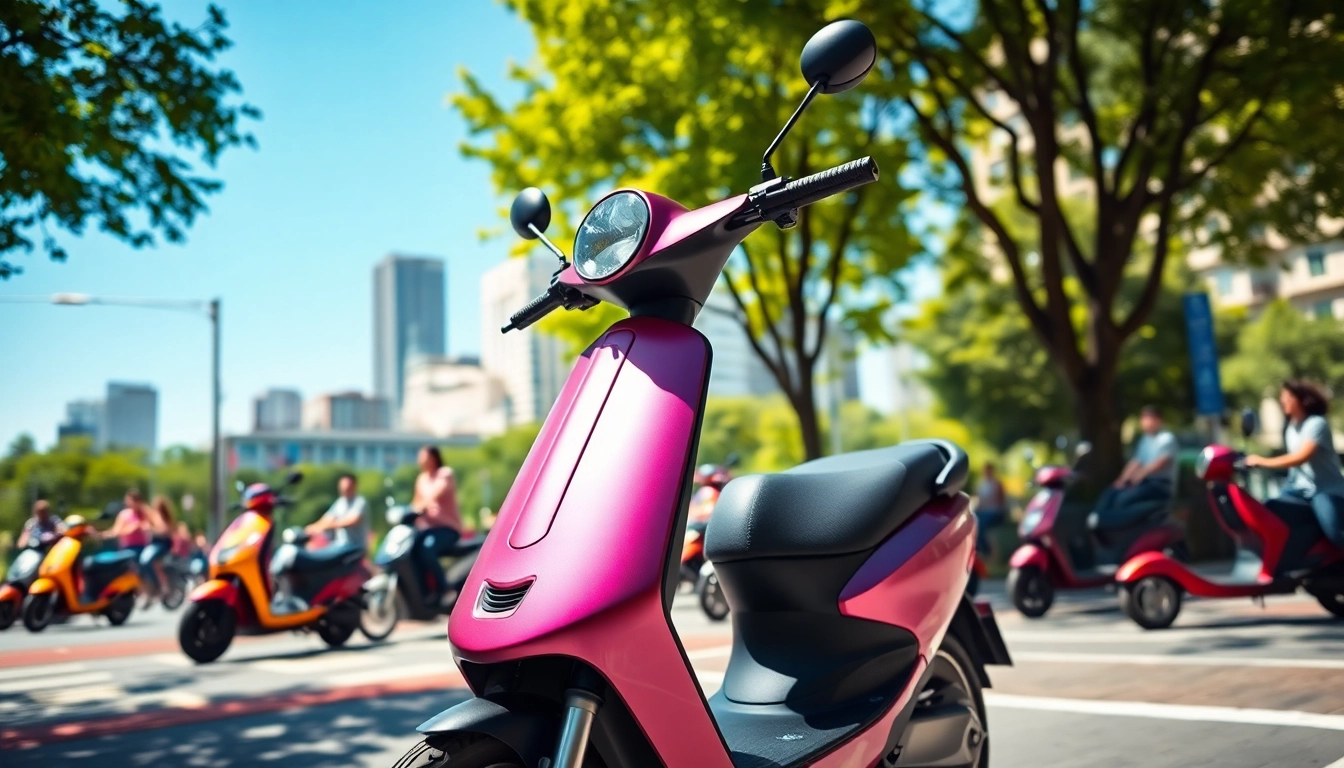Understanding Electric Scooter Basics
What is an Electric Scooter?
An Electric Scooter is a mode of transportation that operates on electric power. It features a platform for the rider to stand on, two wheels, and a steering mechanism, often resembling a traditional kick scooter but enhanced with an electric motor. These scooters have gained immense popularity in recent years, especially in urban areas, due to their ability to navigate congested streets with ease, providing a quick and efficient means of commuting. Their design often emphasizes compactness for easy parking and portability.
Key Components of Electric Scooters
Understanding the key components of electric scooters is essential for prospective buyers and users alike. The main parts include:
- Motor: The heart of the electric scooter, usually located in either the front or rear wheel. Motors can vary in power ranging from 250 watts to 1500 watts, significantly affecting speed and hill-climbing capabilities.
- Battery: This component dictates the range and weight of the scooter. Lithium-ion batteries are the most common, providing a balance between weight, capacity, and longevity.
- Brakes: Electric scooters may feature disc brakes, drum brakes, or regenerative braking systems, enhancing safety by providing effective stopping power.
- Deck: The footboard where riders stand, which can have non-slip surfaces for safety. Size and material can impact riding comfort and stability.
- Wheels: The size and type of wheels affect the ride quality; larger wheels tend to handle bumps better and provide a smoother ride.
- Control System: Typically includes a throttle for acceleration, a display for speed and battery status, and sometimes connectivity options that integrate with smartphones.
Types of Electric Scooters Available
The market offers a variety of scooters tailored to different user needs. Some primary types include:
- Commuter Scooters: Designed for city commuting, these scooters often feature lightweight designs, moderate speed, and decent range.
- Off-Road Scooters: Built for rugged terrain, these have robust tires, enhanced suspension systems, and powerful motors to manage uneven surfaces.
- Sport Electric Scooters: Focused on speed and performance, these scooters typically have powerful motors and advanced braking systems.
- Foldable Scooters: Ideal for individuals needing convenience, these models can be easily stored and transported due to their collapsible design.
Advantages of Using an Electric Scooter
Environmental Benefits of Electric Scooters
One of the significant advantages of electric scooters is their environmental impact. They produce zero emissions during operation, meaning reduced air pollution compared to cars and traditional gas-powered vehicles. With a growing emphasis on sustainability, many urban areas are actively promoting electric scooters as a green alternative for commuting, thereby supporting local efforts to decrease carbon footprints.
Cost-Effectiveness Compared to Traditional Transport
Electric scooters can save users substantial costs over time. While the initial purchase price may vary, the ongoing costs associated with electric scooters are generally lower than those of gasoline-powered vehicles when considering fuel, maintenance, and parking expenses. Electric scooters operate on electricity, which is typically significantly cheaper than gas. Furthermore, they require less maintenance, leading to additional savings in the long run.
Health and Exercise Benefits of Riding
While riding an electric scooter is primarily a convenient form of transportation, it also provides health benefits. Riders engage their muscles when accelerating and maintaining balance, contributing to physical exercise, albeit less than traditional biking. Furthermore, commuting in fresh air can enhance mood and mental health. The leisurely pace allows riders to enjoy their surroundings, improving overall well-being.
Choosing the Right Electric Scooter for Your Needs
Factors to Consider Before Buying
When selecting an electric scooter, several factors should be considered to ensure it meets your needs:
- Purpose: Consider how you plan to use the scooter, whether for daily commuting, recreational rides, or off-road adventures.
- Budget: Set a realistic budget before browsing models, as scooters can range from affordable entry-level options to premium models.
- Range: Assess how far you need to travel on a single charge, as different scooters have varying ranges based on battery capacity.
- Weight: Consider the scooter’s weight, especially if you’ll need to carry it regularly or store it in small spaces.
- Speed: Evaluate what speed is necessary for your commuting needs, ranging from leisurely rides to faster commuting options.
Top Features to Look For in Electric Scooters
When evaluating electric scooters, it’s essential to identify the features that matter most:
- Battery Life: Look for models with long-lasting batteries that can meet your riding demands without frequently needing a recharge.
- Weight Capacity: Ensure the scooter can accommodate your weight and any additional cargo, maintaining performance and safety.
- Safety Features: Check for essential safety features like bright LED lights, reflectors, and a sturdy braking system.
- Portability: Features such as lightweight frames and foldable designs can greatly enhance the practicality of daily use.
- Warranty: A solid warranty often reflects the manufacturer’s confidence in their product and provides peace of mind for consumers.
Comparing Prices and Brands
With a wide array of brands and prices, conducting thorough research before purchasing an electric scooter is vital. Stay informed about consumer reviews and ratings, focusing on the reliability and performance of each model. When comparing prices, remember that the cheapest option may not always offer the best value; balance quality with affordability to ensure satisfaction with your purchase.
Safety Tips for Riding Electric Scooters
Essential Safety Gear for Riders
Safety should be a top priority for electric scooter riders. Essential safety gear includes:
- Helmet: A properly fitted helmet can significantly reduce the risk of serious injury.
- Knee and Elbow Pads: These protect against scrapes and bruises during falls.
- Reflective Gear: Bright, reflective clothing increases visibility, especially at night.
- Gloves: Protect hands from abrasions and provide better grip on handlebars.
Best Practices for Safe Riding
To ensure a safe riding experience, adhere to these best practices:
- Always obey local traffic laws and regulations, respecting pedestrian right-of-way and road signs.
- Be aware of your surroundings, keeping an eye out for obstacles, pedestrians, and vehicles.
- Avoid riding on sidewalks unless allowed, as this can pose risks to pedestrians.
- Use hand signals to communicate your intentions to others on the road.
- Avoid distractions, such as mobile devices, while riding to ensure full attention on the road.
Understanding Local Regulations for Electric Scooters
Different regions and cities have varying rules regarding electric scooter usage. It is crucial to understand these regulations to avoid fines and ensure safe and compliant riding. Research local laws, including where scooters can be ridden, speed limits, and whether registration or insurance is required.
Maintaining Your Electric Scooter for Long Lifespan
Regular Maintenance Practices
To ensure the longevity and performance of your electric scooter, follow these maintenance practices:
- Regular Cleaning: Keep the scooter clean from dirt and debris, especially the wheels and braking systems, to optimize performance.
- Battery Care: Properly charge the battery according to manufacturer guidelines, avoiding extreme temperatures to prolong battery life.
- Tire Maintenance: Check tire pressure regularly and ensure the tread is in good condition to ensure smooth rides.
- Brake Inspection: Regularly examine the brakes for wear and functionality, adjusting or replacing components as necessary.
Common Issues and Troubleshooting
Common problems with electric scooters can include:
- Battery Not Charging: If the battery does not charge, check for connection issues; if persistent, consult a technician.
- Brake Issues: If brakes feel spongy or unresponsive, inspect the brake cables, pads, and discs for wear and replace if needed.
- Uneven Tires: An uneven tire wear indicates alignment issues or weight distribution problems, which can be rectified by checking the wheels and suspension.
When to Seek Professional Help
If you encounter issues beyond general maintenance or worry about the safety and efficacy of key components, it may be time to consult a professional. If any performance concerns arise that you cannot rectify through routine troubleshooting, don’t hesitate to seek expert help. They can provide proper diagnostics and repairs, ensuring your electric scooter remains in optimal condition.



